Comprehensive Report: Travel and Tourism Sector Development
VerifiedAdded on 2019/12/03
|26
|7344
|29
Report
AI Summary
This report provides a comprehensive analysis of the travel and tourism sector. It begins with an introduction to the industry, defining tourism and outlining the report's objectives. Task 1 explores the history of travel and tourism, from early nomadic travels to the development of modern tourism, including the impact of transportation advancements, economic factors, and the evolution of tourism practices. Task 2 delves into the interrelationships and influence of various bodies on the sector, examines the impact of local and national economic policies, and analyzes the implications of political changes in different countries. Task 3 investigates factors affecting demand in the industry, including the impact of supply in special interest tourism. Task 4 discusses the positive and negative impacts of travel and tourism, and explores strategies for minimizing negative impacts while maximizing positive ones. The report utilizes illustrations and figures to support its findings, providing a well-structured overview of the travel and tourism sector's development, structure, and impact.
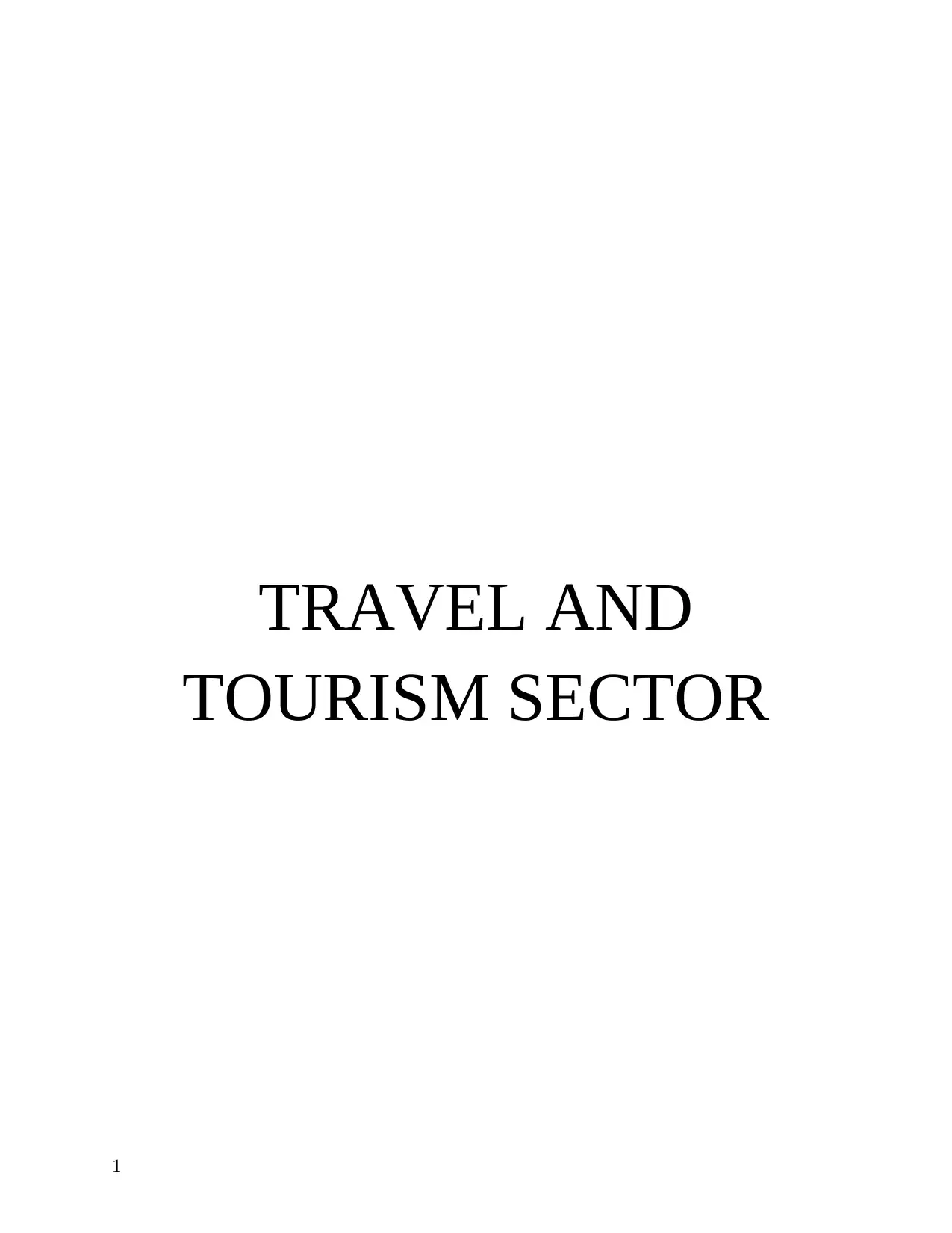
TRAVEL AND
TOURISM SECTOR
1
TOURISM SECTOR
1
Paraphrase This Document
Need a fresh take? Get an instant paraphrase of this document with our AI Paraphraser
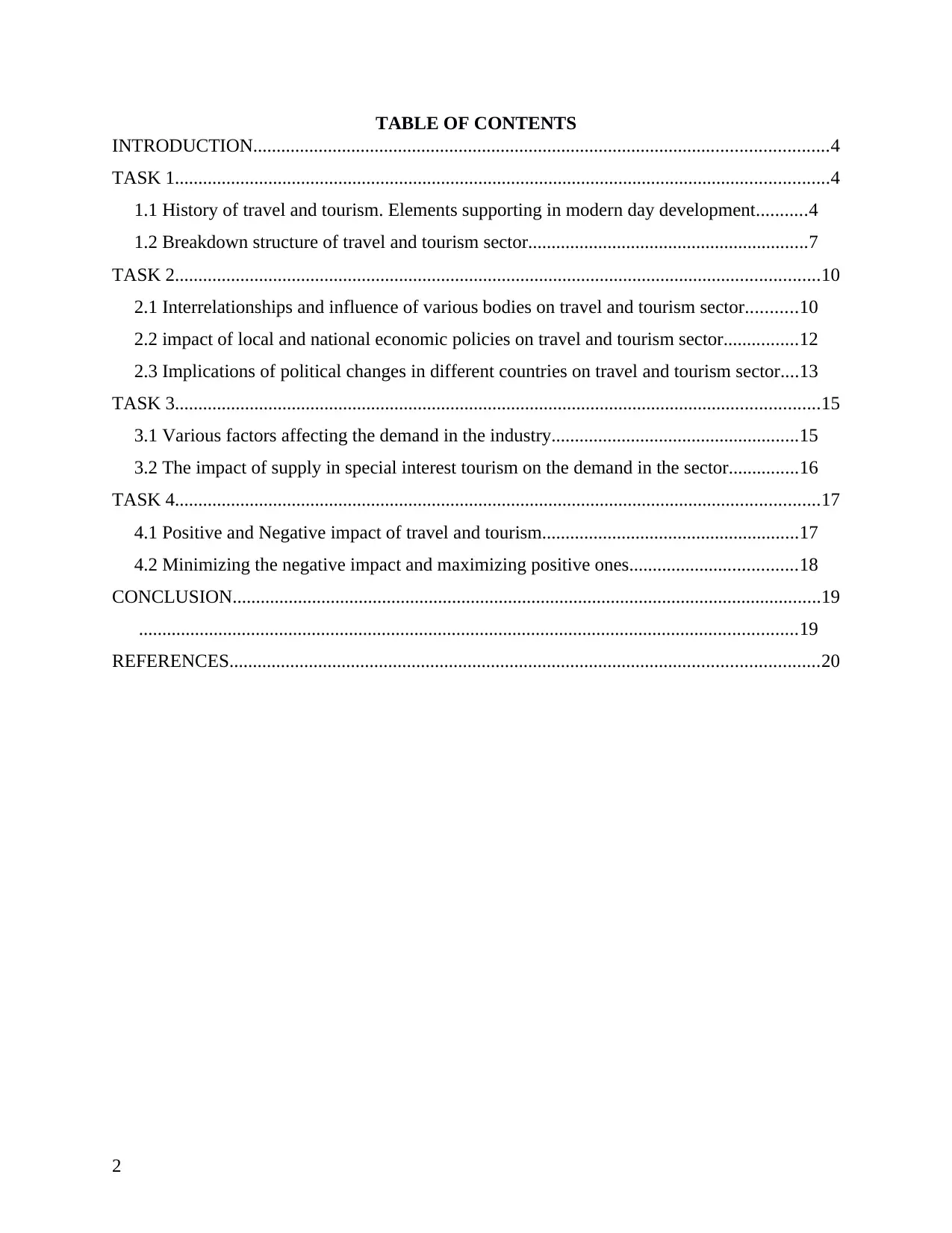
TABLE OF CONTENTS
INTRODUCTION...........................................................................................................................4
TASK 1............................................................................................................................................4
1.1 History of travel and tourism. Elements supporting in modern day development...........4
1.2 Breakdown structure of travel and tourism sector............................................................7
TASK 2..........................................................................................................................................10
2.1 Interrelationships and influence of various bodies on travel and tourism sector...........10
2.2 impact of local and national economic policies on travel and tourism sector................12
2.3 Implications of political changes in different countries on travel and tourism sector....13
TASK 3..........................................................................................................................................15
3.1 Various factors affecting the demand in the industry.....................................................15
3.2 The impact of supply in special interest tourism on the demand in the sector...............16
TASK 4..........................................................................................................................................17
4.1 Positive and Negative impact of travel and tourism.......................................................17
4.2 Minimizing the negative impact and maximizing positive ones....................................18
CONCLUSION..............................................................................................................................19
.............................................................................................................................................19
REFERENCES..............................................................................................................................20
2
INTRODUCTION...........................................................................................................................4
TASK 1............................................................................................................................................4
1.1 History of travel and tourism. Elements supporting in modern day development...........4
1.2 Breakdown structure of travel and tourism sector............................................................7
TASK 2..........................................................................................................................................10
2.1 Interrelationships and influence of various bodies on travel and tourism sector...........10
2.2 impact of local and national economic policies on travel and tourism sector................12
2.3 Implications of political changes in different countries on travel and tourism sector....13
TASK 3..........................................................................................................................................15
3.1 Various factors affecting the demand in the industry.....................................................15
3.2 The impact of supply in special interest tourism on the demand in the sector...............16
TASK 4..........................................................................................................................................17
4.1 Positive and Negative impact of travel and tourism.......................................................17
4.2 Minimizing the negative impact and maximizing positive ones....................................18
CONCLUSION..............................................................................................................................19
.............................................................................................................................................19
REFERENCES..............................................................................................................................20
2
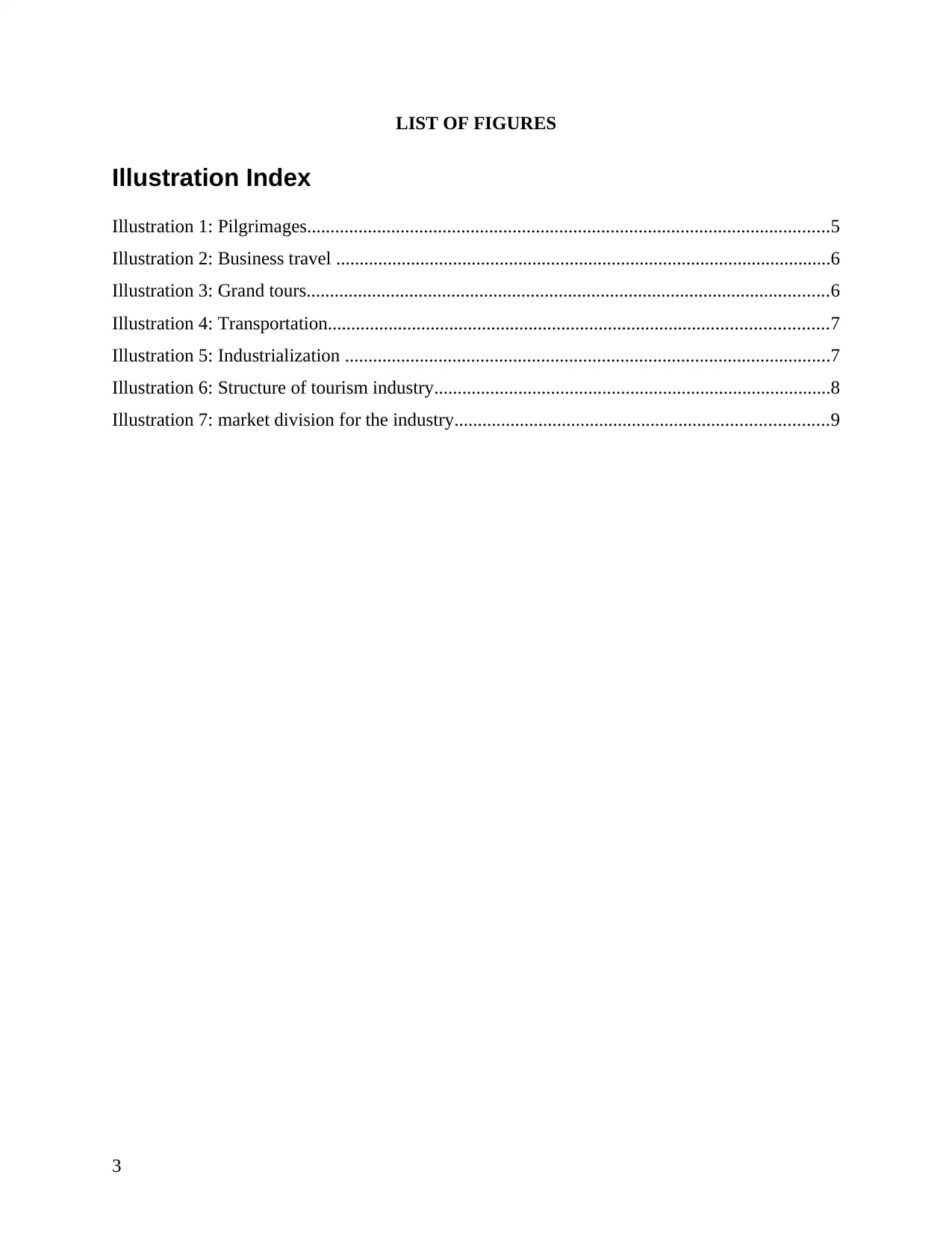
LIST OF FIGURES
Illustration Index
Illustration 1: Pilgrimages................................................................................................................5
Illustration 2: Business travel ..........................................................................................................6
Illustration 3: Grand tours................................................................................................................6
Illustration 4: Transportation...........................................................................................................7
Illustration 5: Industrialization ........................................................................................................7
Illustration 6: Structure of tourism industry.....................................................................................8
Illustration 7: market division for the industry................................................................................9
3
Illustration Index
Illustration 1: Pilgrimages................................................................................................................5
Illustration 2: Business travel ..........................................................................................................6
Illustration 3: Grand tours................................................................................................................6
Illustration 4: Transportation...........................................................................................................7
Illustration 5: Industrialization ........................................................................................................7
Illustration 6: Structure of tourism industry.....................................................................................8
Illustration 7: market division for the industry................................................................................9
3
⊘ This is a preview!⊘
Do you want full access?
Subscribe today to unlock all pages.

Trusted by 1+ million students worldwide
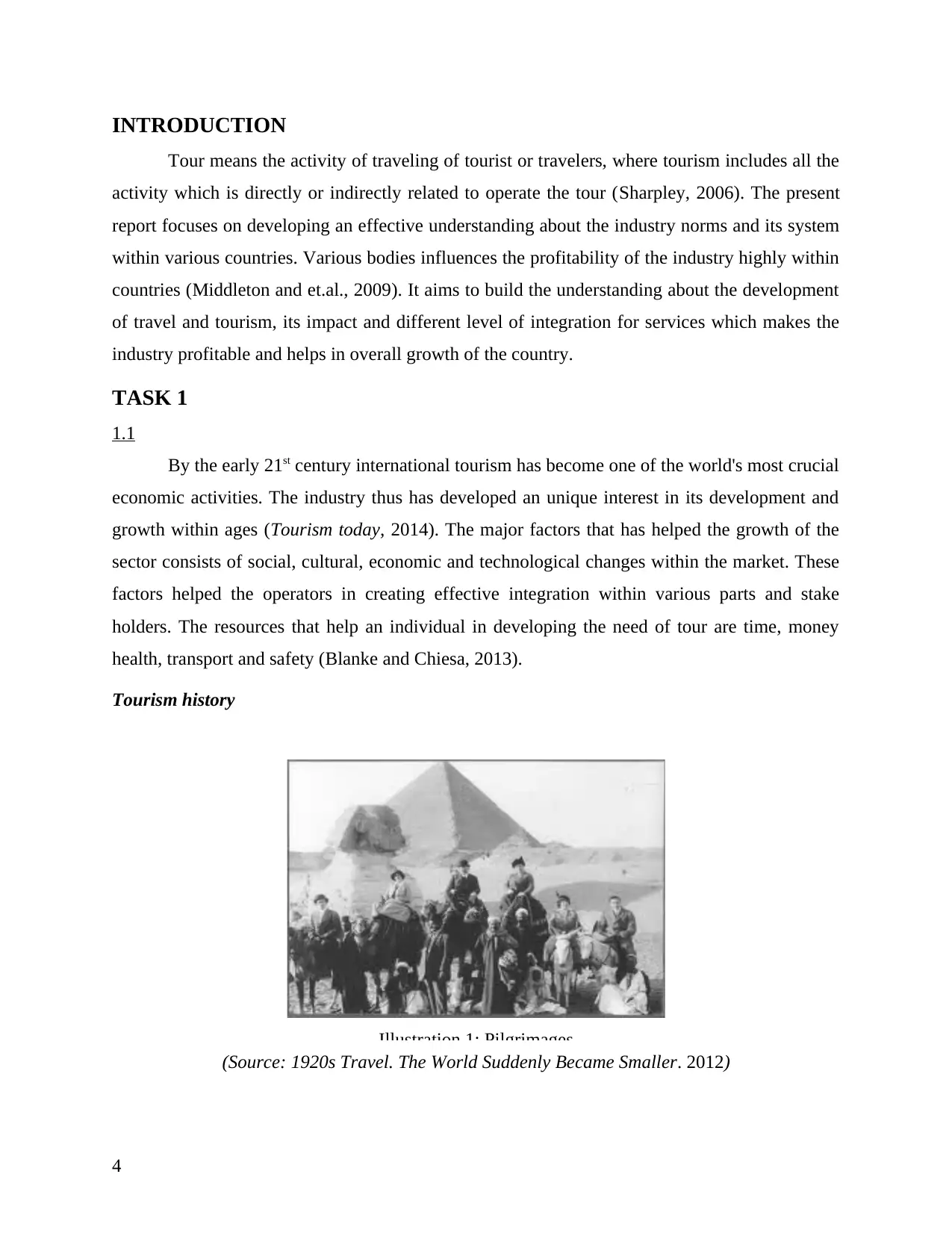
INTRODUCTION
Tour means the activity of traveling of tourist or travelers, where tourism includes all the
activity which is directly or indirectly related to operate the tour (Sharpley, 2006). The present
report focuses on developing an effective understanding about the industry norms and its system
within various countries. Various bodies influences the profitability of the industry highly within
countries (Middleton and et.al., 2009). It aims to build the understanding about the development
of travel and tourism, its impact and different level of integration for services which makes the
industry profitable and helps in overall growth of the country.
TASK 1
1.1
By the early 21st century international tourism has become one of the world's most crucial
economic activities. The industry thus has developed an unique interest in its development and
growth within ages (Tourism today, 2014). The major factors that has helped the growth of the
sector consists of social, cultural, economic and technological changes within the market. These
factors helped the operators in creating effective integration within various parts and stake
holders. The resources that help an individual in developing the need of tour are time, money
health, transport and safety (Blanke and Chiesa, 2013).
Tourism history
(Source: 1920s Travel. The World Suddenly Became Smaller. 2012)
4
Illustration 1: Pilgrimages
Tour means the activity of traveling of tourist or travelers, where tourism includes all the
activity which is directly or indirectly related to operate the tour (Sharpley, 2006). The present
report focuses on developing an effective understanding about the industry norms and its system
within various countries. Various bodies influences the profitability of the industry highly within
countries (Middleton and et.al., 2009). It aims to build the understanding about the development
of travel and tourism, its impact and different level of integration for services which makes the
industry profitable and helps in overall growth of the country.
TASK 1
1.1
By the early 21st century international tourism has become one of the world's most crucial
economic activities. The industry thus has developed an unique interest in its development and
growth within ages (Tourism today, 2014). The major factors that has helped the growth of the
sector consists of social, cultural, economic and technological changes within the market. These
factors helped the operators in creating effective integration within various parts and stake
holders. The resources that help an individual in developing the need of tour are time, money
health, transport and safety (Blanke and Chiesa, 2013).
Tourism history
(Source: 1920s Travel. The World Suddenly Became Smaller. 2012)
4
Illustration 1: Pilgrimages
Paraphrase This Document
Need a fresh take? Get an instant paraphrase of this document with our AI Paraphraser
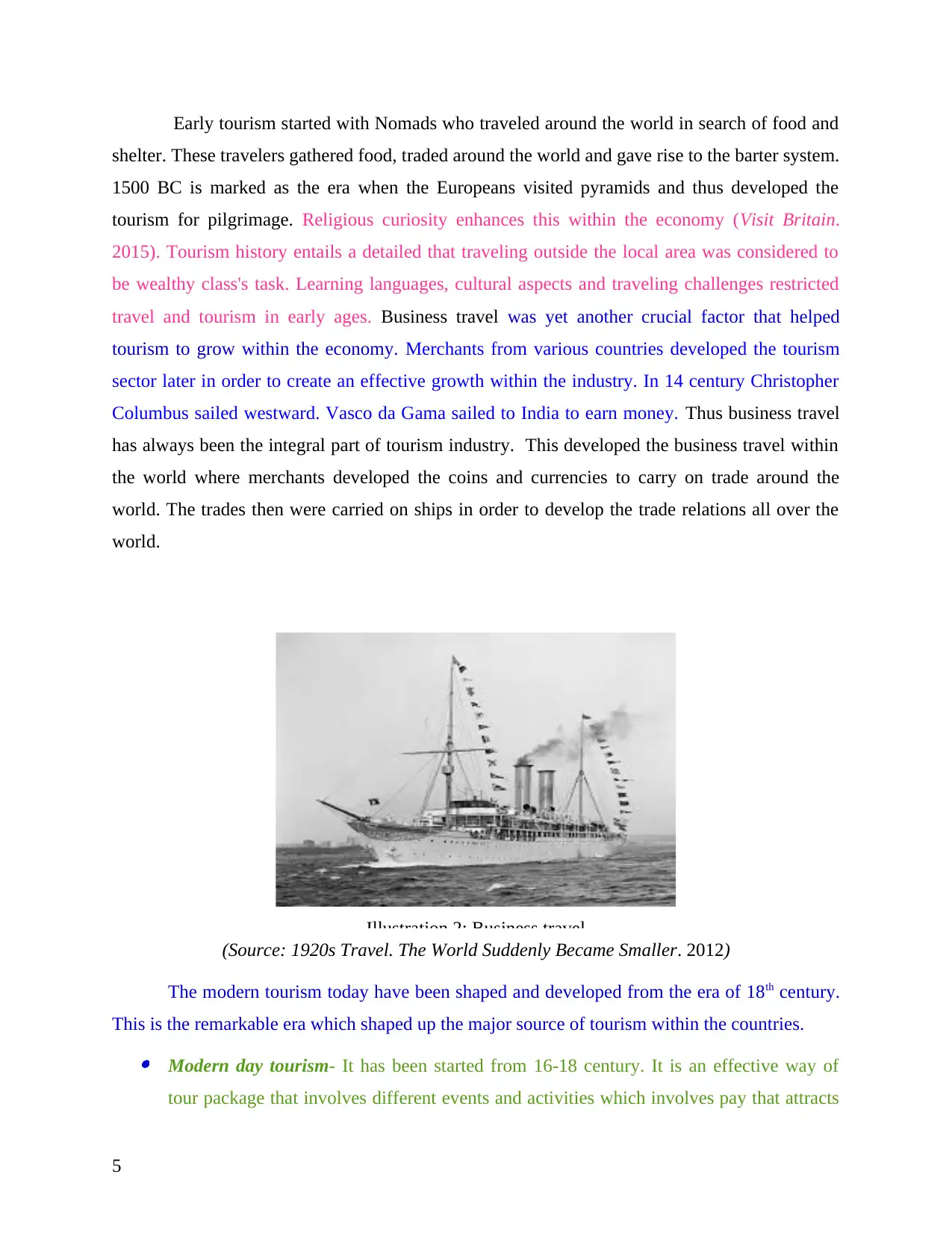
Early tourism started with Nomads who traveled around the world in search of food and
shelter. These travelers gathered food, traded around the world and gave rise to the barter system.
1500 BC is marked as the era when the Europeans visited pyramids and thus developed the
tourism for pilgrimage. Religious curiosity enhances this within the economy (Visit Britain.
2015). Tourism history entails a detailed that traveling outside the local area was considered to
be wealthy class's task. Learning languages, cultural aspects and traveling challenges restricted
travel and tourism in early ages. Business travel was yet another crucial factor that helped
tourism to grow within the economy. Merchants from various countries developed the tourism
sector later in order to create an effective growth within the industry. In 14 century Christopher
Columbus sailed westward. Vasco da Gama sailed to India to earn money. Thus business travel
has always been the integral part of tourism industry. This developed the business travel within
the world where merchants developed the coins and currencies to carry on trade around the
world. The trades then were carried on ships in order to develop the trade relations all over the
world.
(Source: 1920s Travel. The World Suddenly Became Smaller. 2012)
The modern tourism today have been shaped and developed from the era of 18th century.
This is the remarkable era which shaped up the major source of tourism within the countries. Modern day tourism- It has been started from 16-18 century. It is an effective way of
tour package that involves different events and activities which involves pay that attracts
5
Illustration 2: Business travel
shelter. These travelers gathered food, traded around the world and gave rise to the barter system.
1500 BC is marked as the era when the Europeans visited pyramids and thus developed the
tourism for pilgrimage. Religious curiosity enhances this within the economy (Visit Britain.
2015). Tourism history entails a detailed that traveling outside the local area was considered to
be wealthy class's task. Learning languages, cultural aspects and traveling challenges restricted
travel and tourism in early ages. Business travel was yet another crucial factor that helped
tourism to grow within the economy. Merchants from various countries developed the tourism
sector later in order to create an effective growth within the industry. In 14 century Christopher
Columbus sailed westward. Vasco da Gama sailed to India to earn money. Thus business travel
has always been the integral part of tourism industry. This developed the business travel within
the world where merchants developed the coins and currencies to carry on trade around the
world. The trades then were carried on ships in order to develop the trade relations all over the
world.
(Source: 1920s Travel. The World Suddenly Became Smaller. 2012)
The modern tourism today have been shaped and developed from the era of 18th century.
This is the remarkable era which shaped up the major source of tourism within the countries. Modern day tourism- It has been started from 16-18 century. It is an effective way of
tour package that involves different events and activities which involves pay that attracts
5
Illustration 2: Business travel
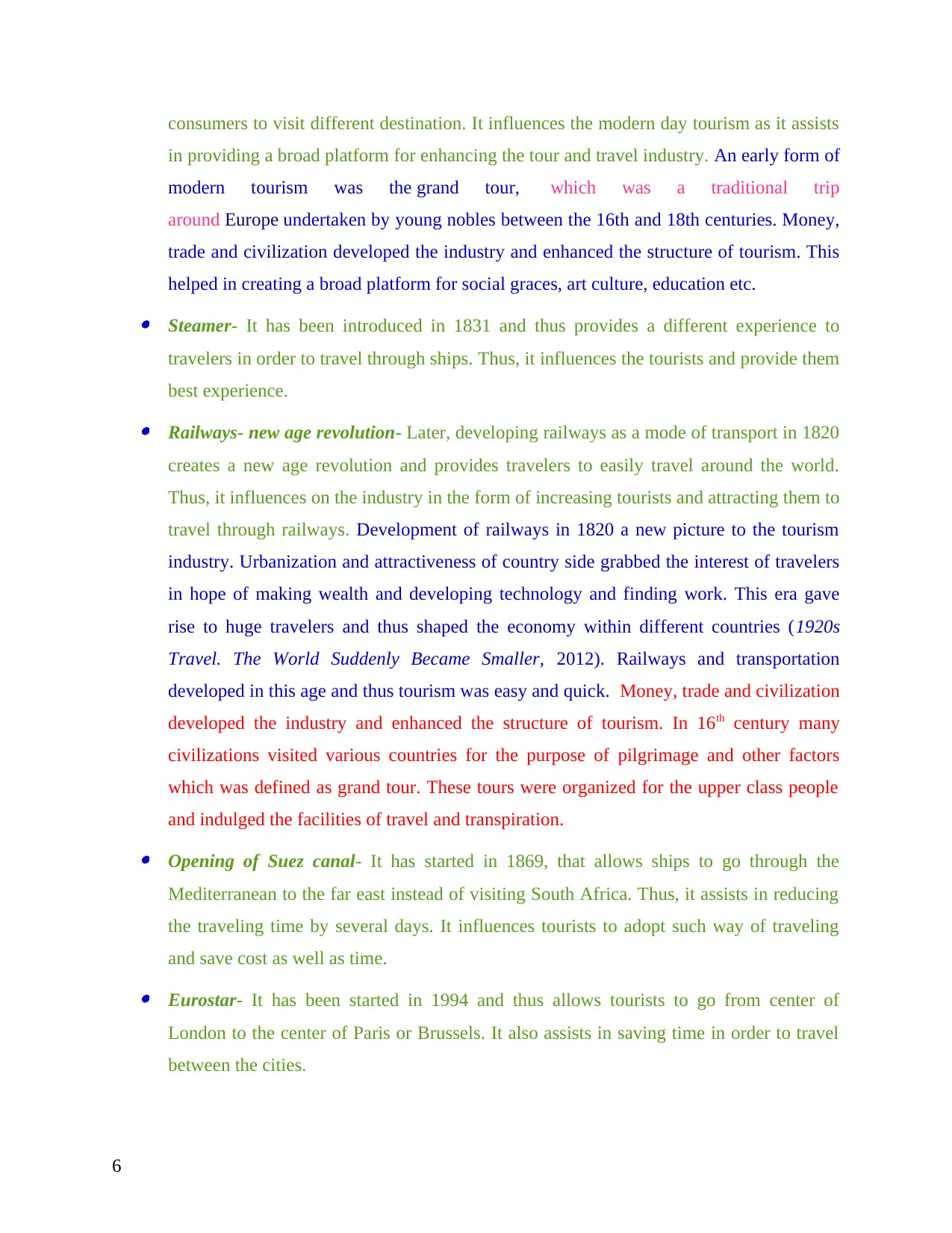
consumers to visit different destination. It influences the modern day tourism as it assists
in providing a broad platform for enhancing the tour and travel industry. An early form of
modern tourism was the grand tour, which was a traditional trip
around Europe undertaken by young nobles between the 16th and 18th centuries. Money,
trade and civilization developed the industry and enhanced the structure of tourism. This
helped in creating a broad platform for social graces, art culture, education etc. Steamer- It has been introduced in 1831 and thus provides a different experience to
travelers in order to travel through ships. Thus, it influences the tourists and provide them
best experience. Railways- new age revolution- Later, developing railways as a mode of transport in 1820
creates a new age revolution and provides travelers to easily travel around the world.
Thus, it influences on the industry in the form of increasing tourists and attracting them to
travel through railways. Development of railways in 1820 a new picture to the tourism
industry. Urbanization and attractiveness of country side grabbed the interest of travelers
in hope of making wealth and developing technology and finding work. This era gave
rise to huge travelers and thus shaped the economy within different countries (1920s
Travel. The World Suddenly Became Smaller, 2012). Railways and transportation
developed in this age and thus tourism was easy and quick. Money, trade and civilization
developed the industry and enhanced the structure of tourism. In 16th century many
civilizations visited various countries for the purpose of pilgrimage and other factors
which was defined as grand tour. These tours were organized for the upper class people
and indulged the facilities of travel and transpiration. Opening of Suez canal- It has started in 1869, that allows ships to go through the
Mediterranean to the far east instead of visiting South Africa. Thus, it assists in reducing
the traveling time by several days. It influences tourists to adopt such way of traveling
and save cost as well as time. Eurostar- It has been started in 1994 and thus allows tourists to go from center of
London to the center of Paris or Brussels. It also assists in saving time in order to travel
between the cities.
6
in providing a broad platform for enhancing the tour and travel industry. An early form of
modern tourism was the grand tour, which was a traditional trip
around Europe undertaken by young nobles between the 16th and 18th centuries. Money,
trade and civilization developed the industry and enhanced the structure of tourism. This
helped in creating a broad platform for social graces, art culture, education etc. Steamer- It has been introduced in 1831 and thus provides a different experience to
travelers in order to travel through ships. Thus, it influences the tourists and provide them
best experience. Railways- new age revolution- Later, developing railways as a mode of transport in 1820
creates a new age revolution and provides travelers to easily travel around the world.
Thus, it influences on the industry in the form of increasing tourists and attracting them to
travel through railways. Development of railways in 1820 a new picture to the tourism
industry. Urbanization and attractiveness of country side grabbed the interest of travelers
in hope of making wealth and developing technology and finding work. This era gave
rise to huge travelers and thus shaped the economy within different countries (1920s
Travel. The World Suddenly Became Smaller, 2012). Railways and transportation
developed in this age and thus tourism was easy and quick. Money, trade and civilization
developed the industry and enhanced the structure of tourism. In 16th century many
civilizations visited various countries for the purpose of pilgrimage and other factors
which was defined as grand tour. These tours were organized for the upper class people
and indulged the facilities of travel and transpiration. Opening of Suez canal- It has started in 1869, that allows ships to go through the
Mediterranean to the far east instead of visiting South Africa. Thus, it assists in reducing
the traveling time by several days. It influences tourists to adopt such way of traveling
and save cost as well as time. Eurostar- It has been started in 1994 and thus allows tourists to go from center of
London to the center of Paris or Brussels. It also assists in saving time in order to travel
between the cities.
6
⊘ This is a preview!⊘
Do you want full access?
Subscribe today to unlock all pages.

Trusted by 1+ million students worldwide
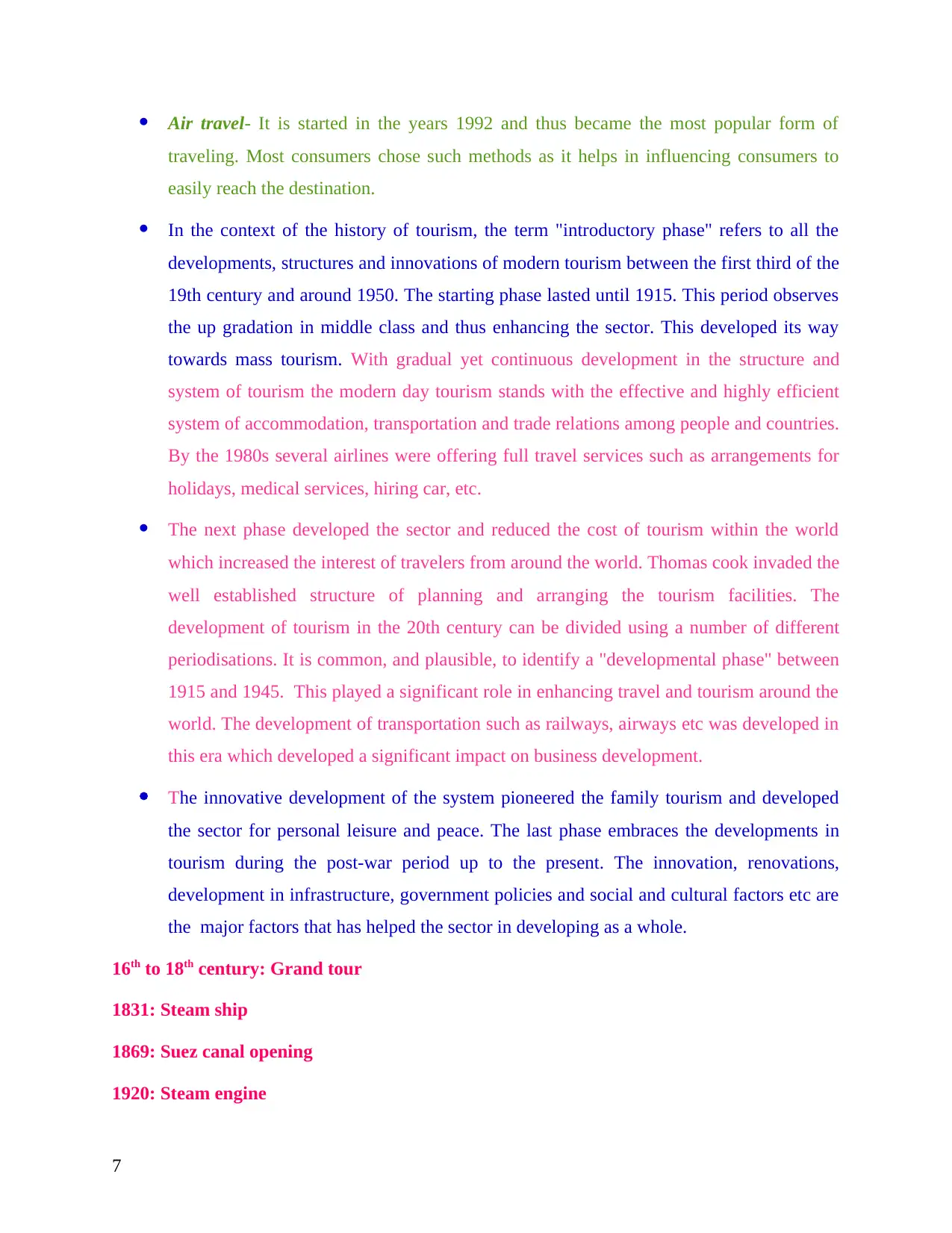
Air travel- It is started in the years 1992 and thus became the most popular form of
traveling. Most consumers chose such methods as it helps in influencing consumers to
easily reach the destination.
In the context of the history of tourism, the term "introductory phase" refers to all the
developments, structures and innovations of modern tourism between the first third of the
19th century and around 1950. The starting phase lasted until 1915. This period observes
the up gradation in middle class and thus enhancing the sector. This developed its way
towards mass tourism. With gradual yet continuous development in the structure and
system of tourism the modern day tourism stands with the effective and highly efficient
system of accommodation, transportation and trade relations among people and countries.
By the 1980s several airlines were offering full travel services such as arrangements for
holidays, medical services, hiring car, etc.
The next phase developed the sector and reduced the cost of tourism within the world
which increased the interest of travelers from around the world. Thomas cook invaded the
well established structure of planning and arranging the tourism facilities. The
development of tourism in the 20th century can be divided using a number of different
periodisations. It is common, and plausible, to identify a "developmental phase" between
1915 and 1945. This played a significant role in enhancing travel and tourism around the
world. The development of transportation such as railways, airways etc was developed in
this era which developed a significant impact on business development.
The innovative development of the system pioneered the family tourism and developed
the sector for personal leisure and peace. The last phase embraces the developments in
tourism during the post-war period up to the present. The innovation, renovations,
development in infrastructure, government policies and social and cultural factors etc are
the major factors that has helped the sector in developing as a whole.
16th to 18th century: Grand tour
1831: Steam ship
1869: Suez canal opening
1920: Steam engine
7
traveling. Most consumers chose such methods as it helps in influencing consumers to
easily reach the destination.
In the context of the history of tourism, the term "introductory phase" refers to all the
developments, structures and innovations of modern tourism between the first third of the
19th century and around 1950. The starting phase lasted until 1915. This period observes
the up gradation in middle class and thus enhancing the sector. This developed its way
towards mass tourism. With gradual yet continuous development in the structure and
system of tourism the modern day tourism stands with the effective and highly efficient
system of accommodation, transportation and trade relations among people and countries.
By the 1980s several airlines were offering full travel services such as arrangements for
holidays, medical services, hiring car, etc.
The next phase developed the sector and reduced the cost of tourism within the world
which increased the interest of travelers from around the world. Thomas cook invaded the
well established structure of planning and arranging the tourism facilities. The
development of tourism in the 20th century can be divided using a number of different
periodisations. It is common, and plausible, to identify a "developmental phase" between
1915 and 1945. This played a significant role in enhancing travel and tourism around the
world. The development of transportation such as railways, airways etc was developed in
this era which developed a significant impact on business development.
The innovative development of the system pioneered the family tourism and developed
the sector for personal leisure and peace. The last phase embraces the developments in
tourism during the post-war period up to the present. The innovation, renovations,
development in infrastructure, government policies and social and cultural factors etc are
the major factors that has helped the sector in developing as a whole.
16th to 18th century: Grand tour
1831: Steam ship
1869: Suez canal opening
1920: Steam engine
7
Paraphrase This Document
Need a fresh take? Get an instant paraphrase of this document with our AI Paraphraser
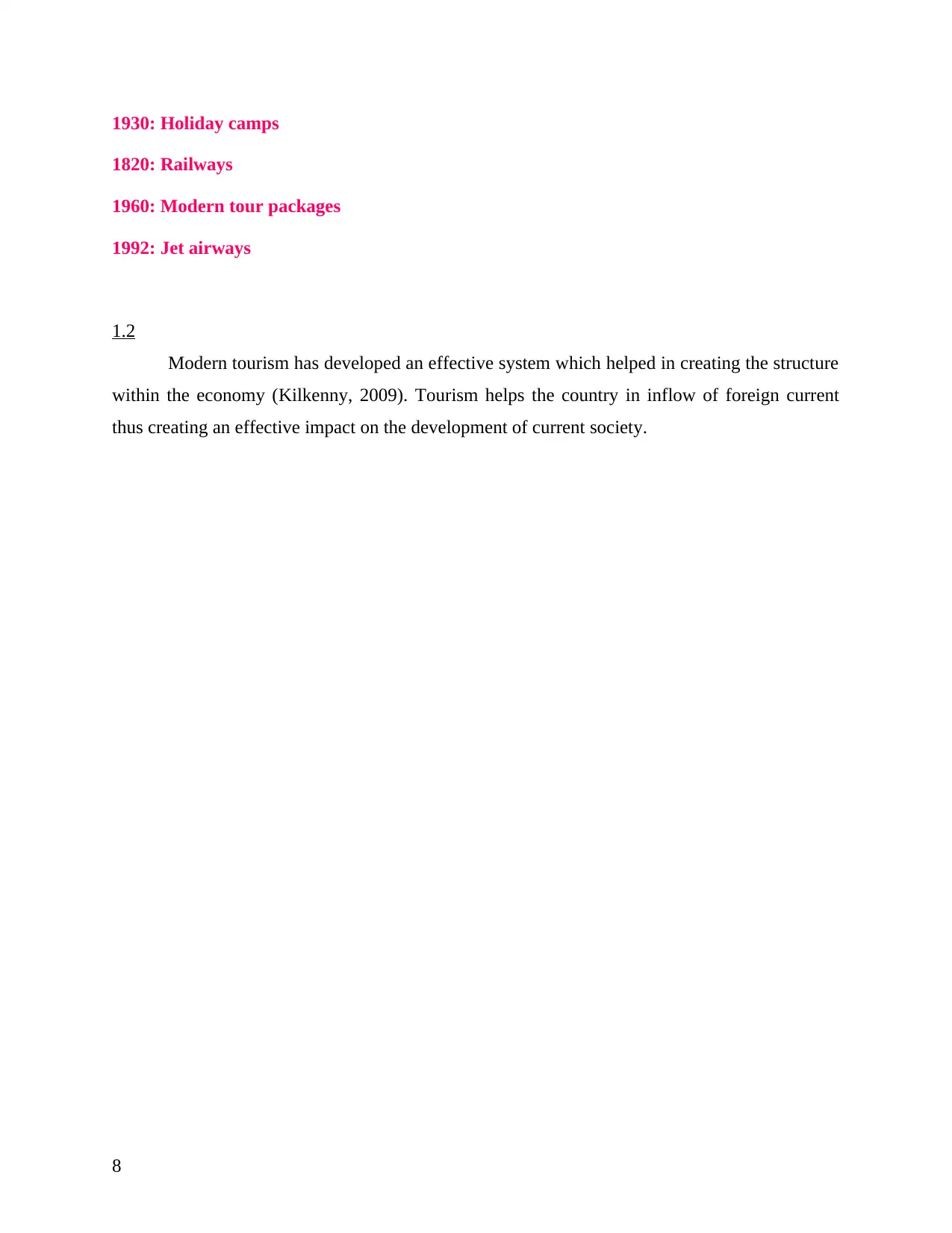
1930: Holiday camps
1820: Railways
1960: Modern tour packages
1992: Jet airways
1.2
Modern tourism has developed an effective system which helped in creating the structure
within the economy (Kilkenny, 2009). Tourism helps the country in inflow of foreign current
thus creating an effective impact on the development of current society.
8
1820: Railways
1960: Modern tour packages
1992: Jet airways
1.2
Modern tourism has developed an effective system which helped in creating the structure
within the economy (Kilkenny, 2009). Tourism helps the country in inflow of foreign current
thus creating an effective impact on the development of current society.
8
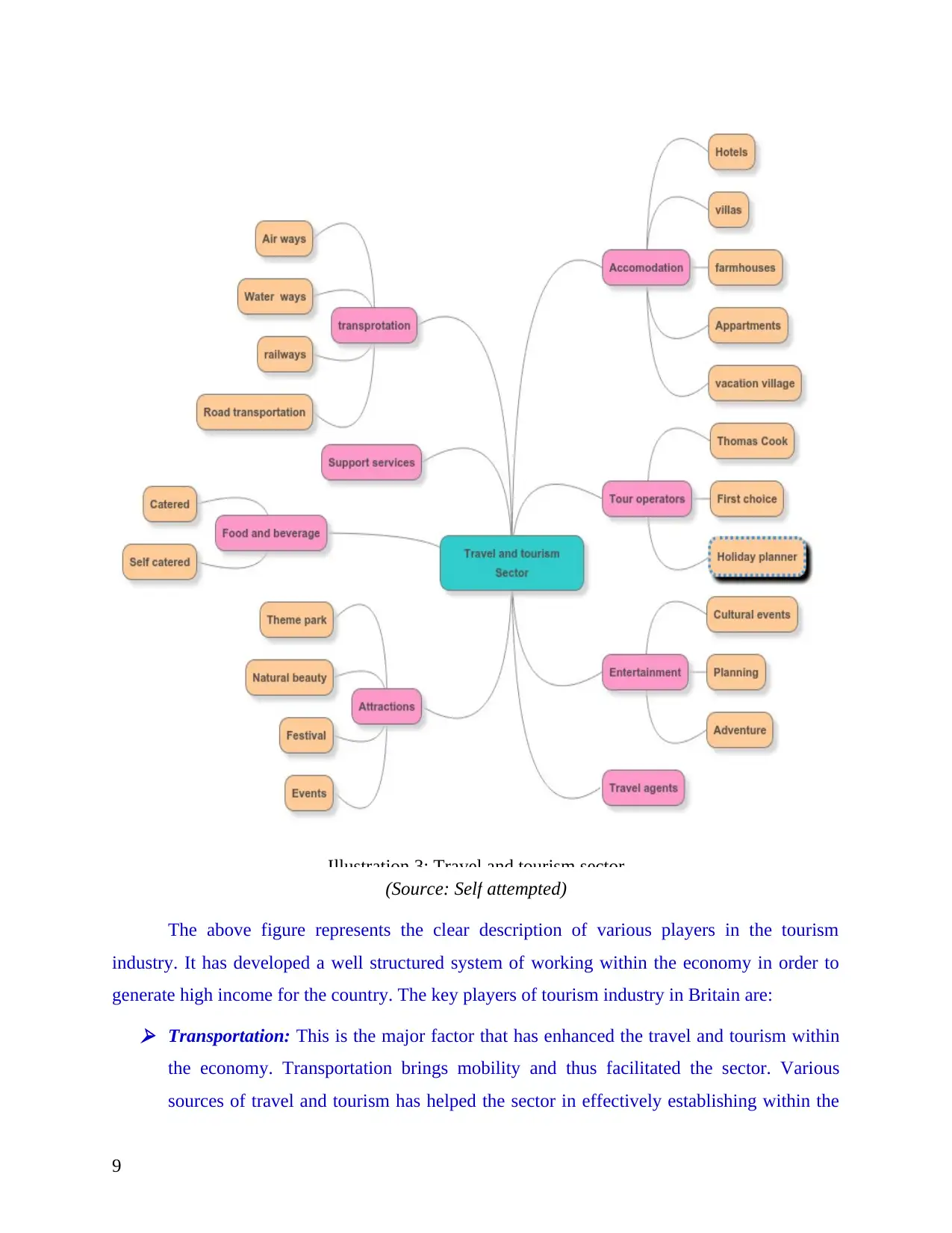
(Source: Self attempted)
The above figure represents the clear description of various players in the tourism
industry. It has developed a well structured system of working within the economy in order to
generate high income for the country. The key players of tourism industry in Britain are: Transportation: This is the major factor that has enhanced the travel and tourism within
the economy. Transportation brings mobility and thus facilitated the sector. Various
sources of travel and tourism has helped the sector in effectively establishing within the
9
Illustration 3: Travel and tourism sector
The above figure represents the clear description of various players in the tourism
industry. It has developed a well structured system of working within the economy in order to
generate high income for the country. The key players of tourism industry in Britain are: Transportation: This is the major factor that has enhanced the travel and tourism within
the economy. Transportation brings mobility and thus facilitated the sector. Various
sources of travel and tourism has helped the sector in effectively establishing within the
9
Illustration 3: Travel and tourism sector
⊘ This is a preview!⊘
Do you want full access?
Subscribe today to unlock all pages.

Trusted by 1+ million students worldwide
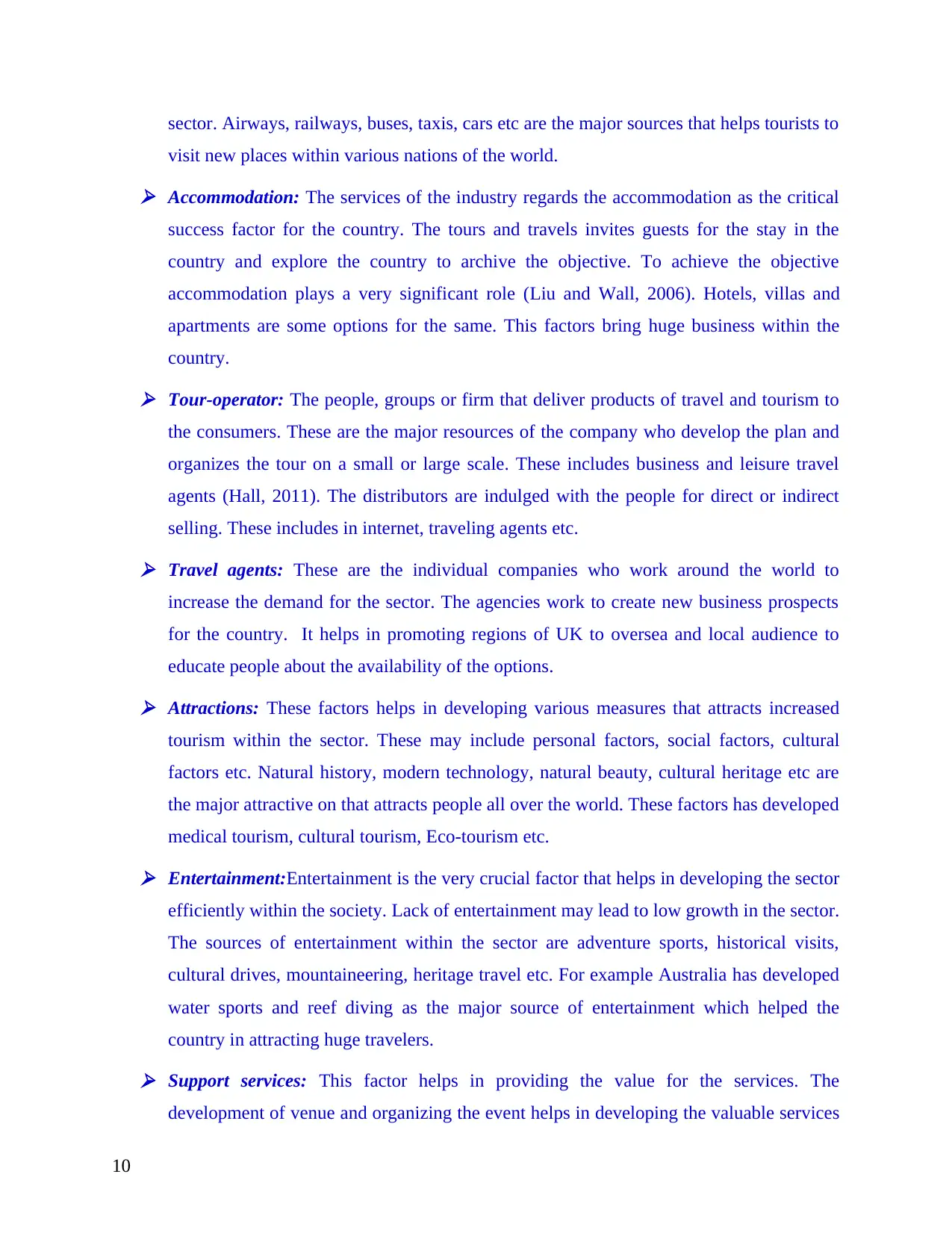
sector. Airways, railways, buses, taxis, cars etc are the major sources that helps tourists to
visit new places within various nations of the world. Accommodation: The services of the industry regards the accommodation as the critical
success factor for the country. The tours and travels invites guests for the stay in the
country and explore the country to archive the objective. To achieve the objective
accommodation plays a very significant role (Liu and Wall, 2006). Hotels, villas and
apartments are some options for the same. This factors bring huge business within the
country. Tour-operator: The people, groups or firm that deliver products of travel and tourism to
the consumers. These are the major resources of the company who develop the plan and
organizes the tour on a small or large scale. These includes business and leisure travel
agents (Hall, 2011). The distributors are indulged with the people for direct or indirect
selling. These includes in internet, traveling agents etc. Travel agents: These are the individual companies who work around the world to
increase the demand for the sector. The agencies work to create new business prospects
for the country. It helps in promoting regions of UK to oversea and local audience to
educate people about the availability of the options. Attractions: These factors helps in developing various measures that attracts increased
tourism within the sector. These may include personal factors, social factors, cultural
factors etc. Natural history, modern technology, natural beauty, cultural heritage etc are
the major attractive on that attracts people all over the world. These factors has developed
medical tourism, cultural tourism, Eco-tourism etc. Entertainment:Entertainment is the very crucial factor that helps in developing the sector
efficiently within the society. Lack of entertainment may lead to low growth in the sector.
The sources of entertainment within the sector are adventure sports, historical visits,
cultural drives, mountaineering, heritage travel etc. For example Australia has developed
water sports and reef diving as the major source of entertainment which helped the
country in attracting huge travelers. Support services: This factor helps in providing the value for the services. The
development of venue and organizing the event helps in developing the valuable services
10
visit new places within various nations of the world. Accommodation: The services of the industry regards the accommodation as the critical
success factor for the country. The tours and travels invites guests for the stay in the
country and explore the country to archive the objective. To achieve the objective
accommodation plays a very significant role (Liu and Wall, 2006). Hotels, villas and
apartments are some options for the same. This factors bring huge business within the
country. Tour-operator: The people, groups or firm that deliver products of travel and tourism to
the consumers. These are the major resources of the company who develop the plan and
organizes the tour on a small or large scale. These includes business and leisure travel
agents (Hall, 2011). The distributors are indulged with the people for direct or indirect
selling. These includes in internet, traveling agents etc. Travel agents: These are the individual companies who work around the world to
increase the demand for the sector. The agencies work to create new business prospects
for the country. It helps in promoting regions of UK to oversea and local audience to
educate people about the availability of the options. Attractions: These factors helps in developing various measures that attracts increased
tourism within the sector. These may include personal factors, social factors, cultural
factors etc. Natural history, modern technology, natural beauty, cultural heritage etc are
the major attractive on that attracts people all over the world. These factors has developed
medical tourism, cultural tourism, Eco-tourism etc. Entertainment:Entertainment is the very crucial factor that helps in developing the sector
efficiently within the society. Lack of entertainment may lead to low growth in the sector.
The sources of entertainment within the sector are adventure sports, historical visits,
cultural drives, mountaineering, heritage travel etc. For example Australia has developed
water sports and reef diving as the major source of entertainment which helped the
country in attracting huge travelers. Support services: This factor helps in providing the value for the services. The
development of venue and organizing the event helps in developing the valuable services
10
Paraphrase This Document
Need a fresh take? Get an instant paraphrase of this document with our AI Paraphraser
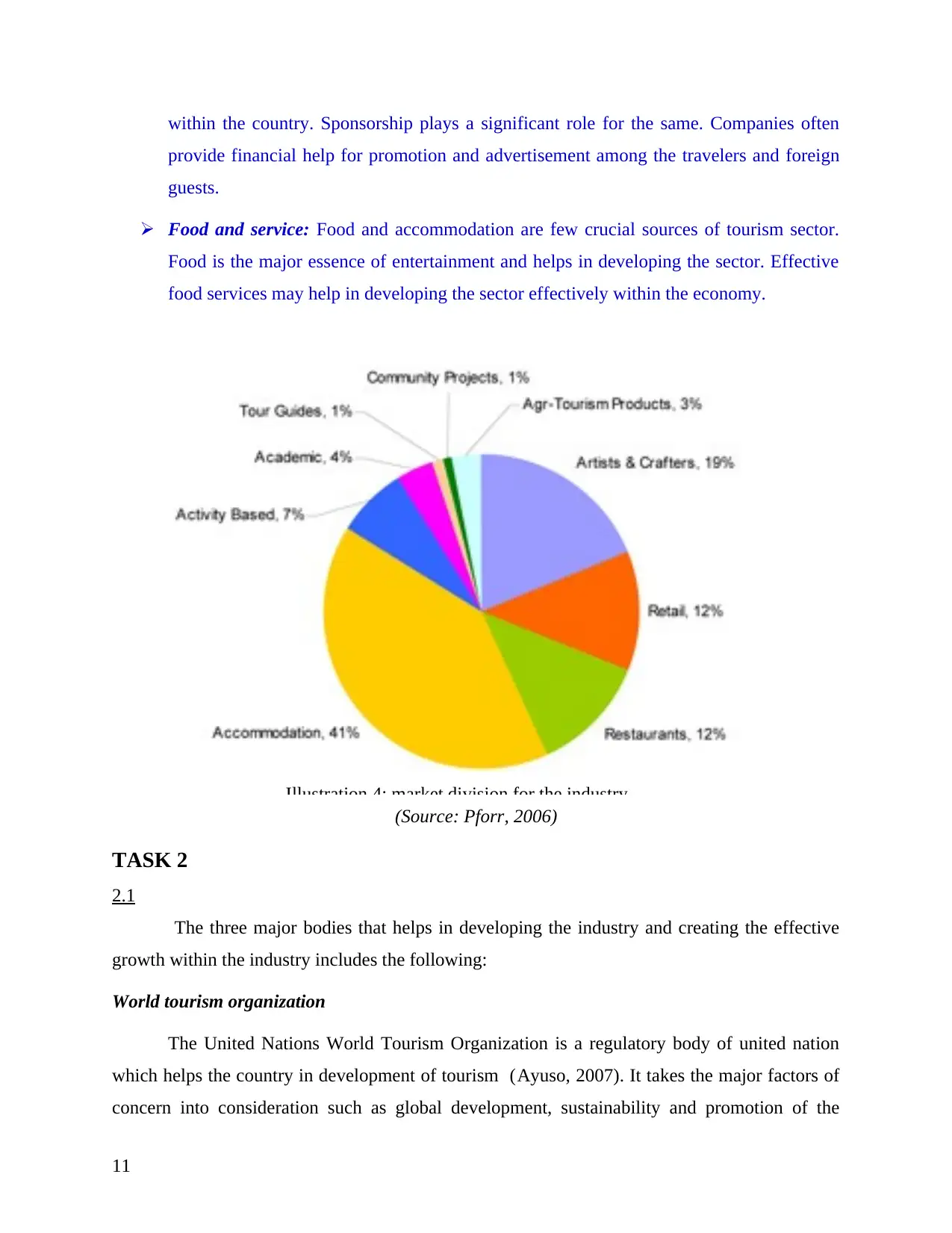
within the country. Sponsorship plays a significant role for the same. Companies often
provide financial help for promotion and advertisement among the travelers and foreign
guests.
Food and service: Food and accommodation are few crucial sources of tourism sector.
Food is the major essence of entertainment and helps in developing the sector. Effective
food services may help in developing the sector effectively within the economy.
(Source: Pforr, 2006)
TASK 2
2.1
The three major bodies that helps in developing the industry and creating the effective
growth within the industry includes the following:
World tourism organization
The United Nations World Tourism Organization is a regulatory body of united nation
which helps the country in development of tourism (Ayuso, 2007). It takes the major factors of
concern into consideration such as global development, sustainability and promotion of the
11
Illustration 4: market division for the industry
provide financial help for promotion and advertisement among the travelers and foreign
guests.
Food and service: Food and accommodation are few crucial sources of tourism sector.
Food is the major essence of entertainment and helps in developing the sector. Effective
food services may help in developing the sector effectively within the economy.
(Source: Pforr, 2006)
TASK 2
2.1
The three major bodies that helps in developing the industry and creating the effective
growth within the industry includes the following:
World tourism organization
The United Nations World Tourism Organization is a regulatory body of united nation
which helps the country in development of tourism (Ayuso, 2007). It takes the major factors of
concern into consideration such as global development, sustainability and promotion of the
11
Illustration 4: market division for the industry
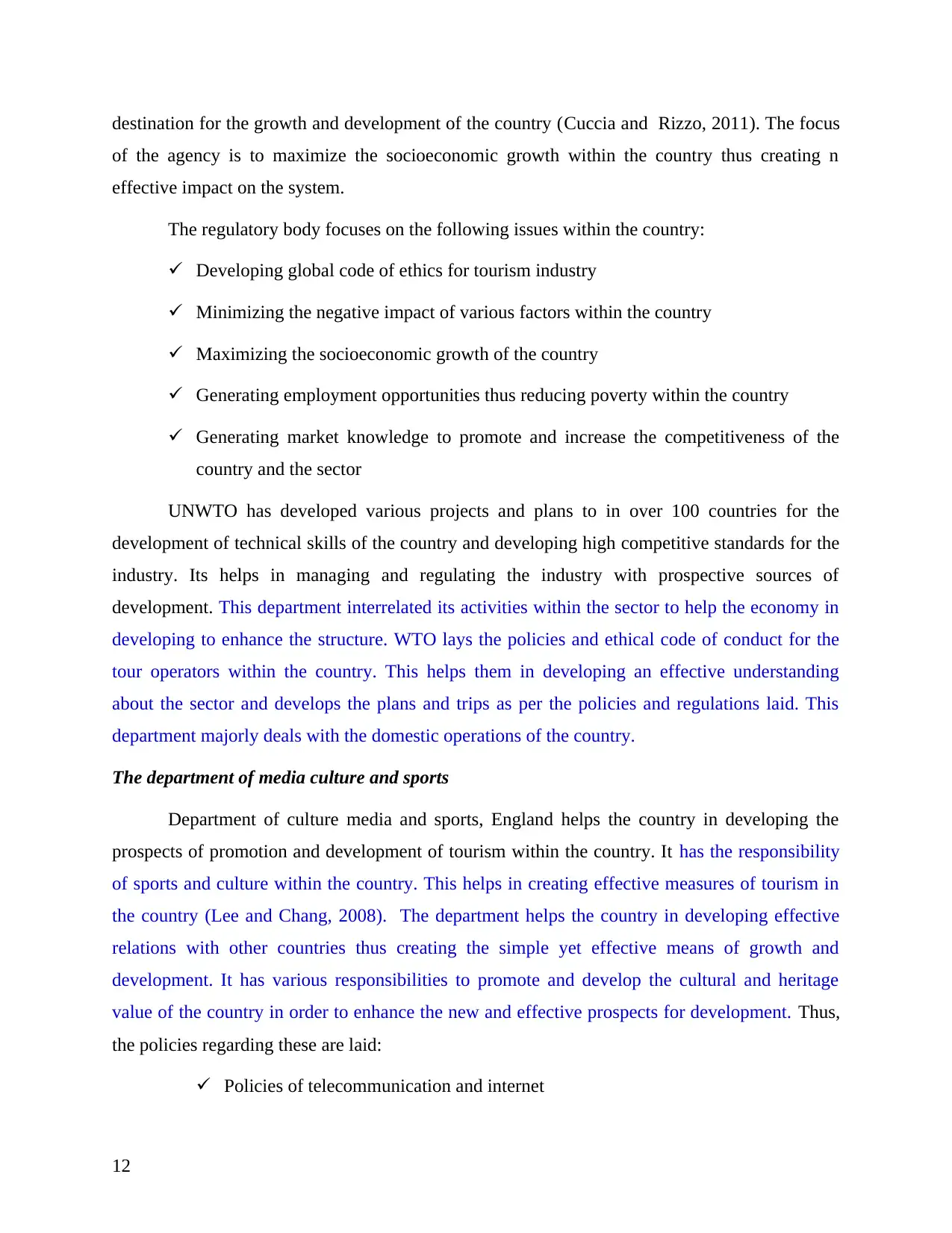
destination for the growth and development of the country (Cuccia and Rizzo, 2011). The focus
of the agency is to maximize the socioeconomic growth within the country thus creating n
effective impact on the system.
The regulatory body focuses on the following issues within the country:
Developing global code of ethics for tourism industry
Minimizing the negative impact of various factors within the country
Maximizing the socioeconomic growth of the country
Generating employment opportunities thus reducing poverty within the country
Generating market knowledge to promote and increase the competitiveness of the
country and the sector
UNWTO has developed various projects and plans to in over 100 countries for the
development of technical skills of the country and developing high competitive standards for the
industry. Its helps in managing and regulating the industry with prospective sources of
development. This department interrelated its activities within the sector to help the economy in
developing to enhance the structure. WTO lays the policies and ethical code of conduct for the
tour operators within the country. This helps them in developing an effective understanding
about the sector and develops the plans and trips as per the policies and regulations laid. This
department majorly deals with the domestic operations of the country.
The department of media culture and sports
Department of culture media and sports, England helps the country in developing the
prospects of promotion and development of tourism within the country. It has the responsibility
of sports and culture within the country. This helps in creating effective measures of tourism in
the country (Lee and Chang, 2008). The department helps the country in developing effective
relations with other countries thus creating the simple yet effective means of growth and
development. It has various responsibilities to promote and develop the cultural and heritage
value of the country in order to enhance the new and effective prospects for development. Thus,
the policies regarding these are laid:
Policies of telecommunication and internet
12
of the agency is to maximize the socioeconomic growth within the country thus creating n
effective impact on the system.
The regulatory body focuses on the following issues within the country:
Developing global code of ethics for tourism industry
Minimizing the negative impact of various factors within the country
Maximizing the socioeconomic growth of the country
Generating employment opportunities thus reducing poverty within the country
Generating market knowledge to promote and increase the competitiveness of the
country and the sector
UNWTO has developed various projects and plans to in over 100 countries for the
development of technical skills of the country and developing high competitive standards for the
industry. Its helps in managing and regulating the industry with prospective sources of
development. This department interrelated its activities within the sector to help the economy in
developing to enhance the structure. WTO lays the policies and ethical code of conduct for the
tour operators within the country. This helps them in developing an effective understanding
about the sector and develops the plans and trips as per the policies and regulations laid. This
department majorly deals with the domestic operations of the country.
The department of media culture and sports
Department of culture media and sports, England helps the country in developing the
prospects of promotion and development of tourism within the country. It has the responsibility
of sports and culture within the country. This helps in creating effective measures of tourism in
the country (Lee and Chang, 2008). The department helps the country in developing effective
relations with other countries thus creating the simple yet effective means of growth and
development. It has various responsibilities to promote and develop the cultural and heritage
value of the country in order to enhance the new and effective prospects for development. Thus,
the policies regarding these are laid:
Policies of telecommunication and internet
12
⊘ This is a preview!⊘
Do you want full access?
Subscribe today to unlock all pages.

Trusted by 1+ million students worldwide
1 out of 26
Related Documents
Your All-in-One AI-Powered Toolkit for Academic Success.
+13062052269
info@desklib.com
Available 24*7 on WhatsApp / Email
![[object Object]](/_next/static/media/star-bottom.7253800d.svg)
Unlock your academic potential
Copyright © 2020–2025 A2Z Services. All Rights Reserved. Developed and managed by ZUCOL.





